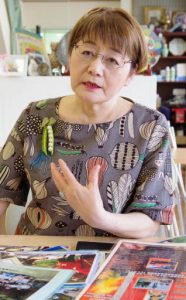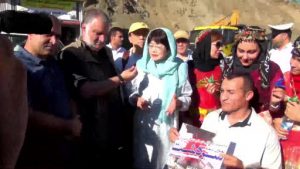Interactions between Iran and Hiroshima made into movie—Poison gas victims visit A-bombed city of Hiroshima and regain “hope”
Jun. 19, 2021
Movie to be screened in Yokogawa in August with aim of raising awareness of poison gas victims’ circumstances
by Yota Baba, Staff Writer
A movie depicting interactions between Iranian victims of poison gas attacks during the Iran–Iraq War in the 1980s and the non-profit organization MOCT, based in Hiroshima’s Higashi Ward, was recently completed and, in May of this year, shown on screen for the first time at the Fajr International Film Festival in Iran. The film depicts poison gas victims suffering under the weight of their experiences but regaining their hopes for life and peace, inspired by the connections they made in their visit to the A-bombed city of Hiroshima. The movie will appear on movie screens in Hiroshima City in August.
The movie, an Iran–Japan co-production, is titled “Legend of Bonasan: The Genie in the Lamp.” It depicts Shizuko Tsuya, 66, chair of MOCT, inviting poison gas victims to Hiroshima after she learned of their suffering from respiratory and eye problems even now, more than ten years after the poison gas attacks. “Bonasan,” the nickname of a male interpreter who served as a bridge between the two sides, was used for the movie title. In the movie, he plays the role of genie and acts as a guide for the story.
Habib Ahmadzadeh, the movie’s director and chair of an organization representing the victims of chemical weapons, proposed producing a movie to express appreciation for the chance to communicate with people in Hiroshima. Ms. Tsuya agreed to the proposal on the condition that the movie provide an opportunity to convey to the world a message about the damage wrought by poison gas. She, alongside Iranian actors, appears in the movie together with an Austrian doctor who made extraordinary efforts to help poison gas victims.
MOCT started its assistance activities after Ms. Tsuya visited Iran in April 2004 as a member of the Hiroshima World Peace Mission, which was organized by the Hiroshima International Cultural Foundation and which dispatched citizens from the A-bombed city of Hiroshima to conflict zones and other locations around the world. Driven by the anguished cry “Everyone knows about Hiroshima, but nobody knows about us” that Ms. Tsuya heard in Iran, MOCT began having interactions with Iran.
One scene in the movie shows a chemical-weapons victim weeping because, he explained, he had regained hope after people listened to him for the first time in Hiroshima. The camera also captured Ms. Tsuya finding released from her own anguish after being delighted about the changes that appeared in the poison gas victims. “Support efforts don’t have to be all about the supply of materials,” she said, sincerely describing her feelings as she looked back on the 17 years of work she put into such activities. “We were able to provide each other with ‘medicine for the soul’ through person-to-person interaction.”
In Hiroshima City, the movie will be screened during August 1–7 as part of the “Hiroshima–Iran Love & Peace Film Festival,” to be held in Yokogawa Cinema (in Hiroshima’s Nishi Ward).
Keywords
Damage wrought by poison gas in Iran
During the Iran-Iraq War (1980–1988), Iraqi forces used such chemical weapons as mustard gas mainly near its border areas. It has been reported that more than 100,000 people were killed or injured and that about 60,000 people suffered from respiratory and eye problems, among other problems, as aftereffects from the poison gas attacks.
(Originally published on June 19, 2021)









